This was published 1 year ago
Casualties of war: the reporters paying a high price for doing their job
During the Iraq War, US forces, mistaking a press photographer’s camera for a weapon, shot him and several civilians. The slaying was met with global outrage after Julian Assange put classified footage online. For one Australian, the deaths left a traumatic mark.
By Dean Yates
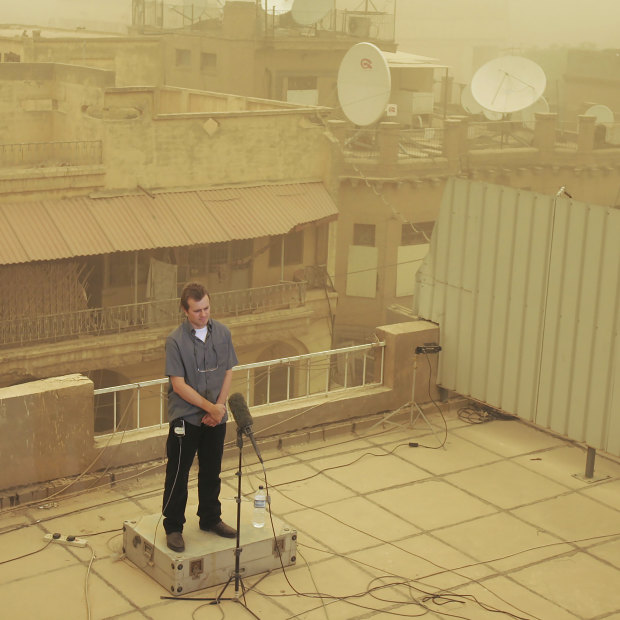
Dean Yates, then Reuters’ Iraq bureau chief, on the roof of his Baghdad office in 2008. Credit: Reuters
Loud wailing suddenly breaks out at the back of the Reuters house in Baghdad, near a small room where the drivers relax and drink coffee.
I stand up, heart pounding, senses primed. Something terrible has happened; the pitch of the anguish is not of this earth. A young Iraqi cameraman bursts through the door. I’ll never forget the horror and pain on his face, his hands clutching his head. He speaks rapidly in Arabic. A senior Iraqi journalist sitting next to me has also got up.
“Namir and Saeed have been killed,” he translates. “Possible US helicopter attack.” I walk towards them, trying to ignore the tightness in my chest. Staff are pouring into the newsroom, shouting in Arabic. I can’t show emotion, I need to show leadership.
“Let’s get all the information we can,” I say.
Colleagues try Namir’s phone, but it keeps ringing out. Saeed’s appears to be switched off or isn’t working. Several photographers and cameramen get in cars and rush to the al-Amin neighbourhood, where Namir earlier told colleagues he was going to check out reports of a US air strike at dawn. I take a few deep breaths and call the global news editor in London, somehow keeping my voice under control: “I’ve got terrible news. It looks like two Iraqi staff have been killed.”
It’s the morning of July 12, 2007, at the height of the Iraq War. Namir Noor-Eldeen is a combat photographer for Reuters, the international news agency, and a veteran of the conflict at 22. With him is driver Saeed Chmagh, a 40-year-old father of four who knows al-Amin well.
More than four years have passed since US President George W. Bush ousted Saddam Hussein and then, with wilful neglect, left the people of Iraq open to unimaginable horror.
Reuters covers the war from a two-storey house the company has rented since Hussein’s downfall. We employ nearly 100 Iraqi journalists and support staff across the country. Concrete blast walls three-and-a-half-metres high surround the house. Iraqi guards with AK-47 assault rifles are posted at metal gates built into each wall and checkpoints at either end of the street.
Our house is on the eastern side of the Tigris river, which splits Baghdad roughly in half. We are in the so-called Red Zone, the name for the city outside the heavily fortified Green Zone, an enclave for Iraq’s fractured leadership, the American embassy, and the headquarters of the US military. I’ve been the Iraq bureau chief for six months.
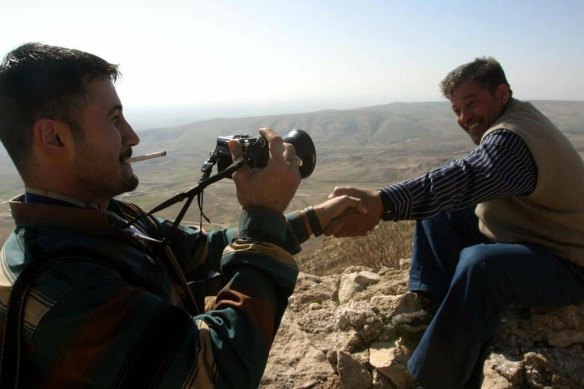
Reuters combat photographer Namir Noor-Eldeen (left) and driver Saeed Chmagh, who were killed in Iraq by US forces.
A photographer finds Namir’s body in a hospital morgue with no electricity and packs it with ice. I can’t remember who found Saeed. People in al-Amin tell my staff a US helicopter attacked a group of men that included Namir and Saeed. US soldiers took Namir’s cameras, they said, which means we can’t review what he’d been photographing. I email the US military spokesman for Iraq, a one-star general in the Green Zone, telling him what I know. He replies quickly, saying he will check.
The bureau is in full-scale crisis now. Many staff are wailing. I study footage and photographs my staff bring back from the scene. They show bewildered residents standing next to a dusty turquoise minivan, its front torn off. There is a pool of blood near a kerb, but no bodies. The road, pavement and walls are pockmarked by heavy-calibre ammunition. Iraqi police call the attack “random American bombardment” and put the death toll at 12. Nothing makes sense.
I get an email from a colleague at another foreign media organisation expressing sadness about Namir and Saeed but also wanting to confirm their deaths. Of course, this is news. More emails follow. All my foreign colleagues wait until I write a short story before reporting. This makes it real, not a nightmare. Doing something I’ve done thousands of times for Reuters across Asia and the Middle East for 15 years.
BAGHDAD, July 12, (Reuters) – An Iraqi photographer and driver working for Reuters in Iraq were killed in Baghdad on Thursday in what police said was American military action and which witnesses described as a helicopter attack.
The sheer amount of work keeps me focused: debriefing Iraqi reporters trying to find out what happened, supporting my staff and updating my editors in London. More precisely, the work, the responsibility I carry, stops me falling apart. The unravelling will come nearly a decade later at my home in rural Tasmania. An accumulation of trauma; breathing in the ashes of a bombed nightclub in Bali; seeing thousands of dead bodies after the most devastating tsunami in history; pushing myself to the limit covering earthquakes that no one will remember.
By early evening, the US military has still said nothing. I press the spokesman for comment and the return of Namir’s cameras. I’ve updated the initial story twice.
Just after midnight, the US military issues a statement saying US forces returned fire and called in helicopter support after being attacked with small arms and RPGs [rocket-propelled grenades].
“There is no question that Coalition Forces were clearly engaged in combat operations against a hostile force,” says a spokesperson for US forces in Baghdad, a lieutenant-colonel.
The assertion that Namir and Saeed were killed in a firefight is a lie, but I don’t know that yet. It will be the first of many lies the US military and government tells over the coming years about this terrible day.
Ten days later, I’m sitting opposite two American generals and a small TV monitor in a nondescript room inside Saddam Hussein’s former Republican Palace in the Green Zone. The military returned Namir’s cameras a few days after he was killed. They weren’t tampered with. No photos deleted. There were no images of fighting or people running for cover. No gunmen.
Witnesses and residents I’d interviewed in the Reuters office said there hadn’t been any clashes to explain the helicopter strike, nor had they seen
gunmen. It was obvious Namir and Saeed weren’t killed in a firefight. I’ve come to the Republican Palace to hear the results of the military’s investigation into Namir and Saeed’s deaths. I’m convinced they were killed in cold blood.
The briefing is off the record, which means I won’t be able to report anything for Reuters. Michael Lawrence, the global news editor, is next to me. A fellow Australian, he’s flown in from London. We sit on one side of a table, two generals in desert camouflage uniforms on the other.
The spokesman is an avuncular figure with greying hair and a moustache. The other general is tall, 10 years older than me. He oversaw the investigation and does most of the talking. He says hundreds of soldiers from the 2nd Battalion, 16th Infantry Regiment had been operating in al-Amin since dawn on July 12 to clear out Shi’ite militias. After coming under attack from small-arms fire and RPGs, the 2–16 requested air support.
Two Apaches arrived and spotted eight to 10 men. The group formed, dispersed, then formed again, he said. They appeared to be “conferring”. Some of the men could “clearly” be seen carrying rifles and RPGs. Units of the 2–16 had come under fire elsewhere in al-Amin a bit earlier, he said. While no shooting came from the group that included Namir and Saeed, the 2–16 gave the Apaches clearance to attack.
What do you mean, Michael and I ask, no one fired on US forces? The presence of armed men was an expression of “hostile intent” and thus the group could be “engaged”, the investigating general says.
My head spins. How can this be hostile intent?
An initial burst of fire from one Apache killed seven “military-aged” men, the investigating general says. We are shown photographs. The general then says he will show us footage from this Apache, which has the call-sign Crazy Horse 1–8.
I have little time to think before a TV a bit bigger than a shoebox flickers to life. It’s a grainy black-and-white scene, the opening of the most controversial footage in the history of war. Australian Julian Assange will publish this classified footage from the gun-camera of Crazy Horse 1–8 in April 2010, horrifying people around the globe. International legal experts call the attack on the minivan that killed Saeed a war crime. Assange calls the tape “Collateral Murder”. He, too, will be haunted by the video, but for different reasons.
In the footage, I see the rooftops of al-Amin, a mosque, walled compounds clustered together. The gunner alerts the pilot to the group of men. The Apache’s camera zooms in and with deepening dread I recognise Saeed because he is a bit overweight and then Namir by the slightly bow-legged way he walks. They each have a camera over their shoulders. Another man has a long, cylindrical object pointed downward, which the investigating general says is an RPG. Two more men appear to have rifles, carried loosely.
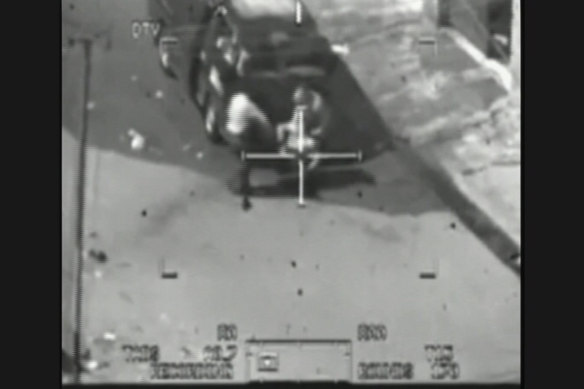
A still from the footage of the attack.
No US or Iraqi forces are visible. No firefight.
My heart races.
“Hotel 2–6, Crazy Horse 1–8. Have five to six individuals with AK-47s. Request permission to engage,” says the Crazy Horse 1–8 gunner in a matter-of-fact voice, using the call-sign of the infantry battalion below.
“Roger that. Uh. We have no personnel east of our position. So, uh, you are free to engage, over,” comes the reply.
Houses block Crazy Horse 1–8’s line of sight. It will have to do a loop. Namir walks ahead, peers around a corner and crouches. He points his long-lensed camera down a street at US Humvees crossing the road, about 100 metres away.
“He’s got an RPG,” the gunner says, agitated.
Seconds later, Crazy Horse 1–8 is in position.
“Light ’em all up!” says the pilot.
Cannon shells from the Apache’s M230 chain gun crash into the men.
The tape is stopped. I lean forward, head in my hands. I’m speechless. I can barely breathe.
Oh my god. Namir looked so suspicious.
Further footage shows a minivan stopping to help the wounded, adds the investigating general. The driver was believed to be aiding insurgents, so the helicopter attacked again. Michael asks to see this footage. The generals refuse. Michael asks for copies of the video and photographs. Again, the answer is no. Reuters must request them under the US Freedom of Information Act. (The Pentagon will stonewall until Assange publishes the tape and even then, the military will say it can’t find the video.)
The generals don’t apologise for the “firefight” lie or seek to explain. I’m too shocked to remonstrate. With no warning, we’ve just watched Namir and Saeed walk into their deaths. Less than three minutes of footage.
I leave the Republican Palace with one image seared into my brain: Namir peering around that corner.
More than nine years later, in August 2016, I’m sitting with my psychiatrist in Ward 17, a unit run by Austin Health in Melbourne that specialises in treating PTSD among veterans and first responders.
Dr Maryam was born in Iran. She has walked in my world. Maryam has pale skin and long black hair parted in the middle. Her face radiates intelligence and kindness. I’ve told Maryam how my volcanic anger has turned my home into a minefield for the people I love most in the world. My partner Mary and teenaged children Patrick, Belle and Harry freeze if anyone drops something or slams a door. They try to second-guess my moods. Tiny things irritate me while depression sucks me dry.
Dozens of sights and sounds began intruding into my head years ago. Intermittent at first, frequent now: the severed hand I almost trod on in the bombed Sari Club in Kuta Beach; the 158 bloated bodies I counted in a mosque in Banda Aceh after the 2004 Boxing Day tsunami; the wailing at the back of the Reuters house in Baghdad. I never thought a man could sound so grief-stricken.
Gunmen chase me through the streets of Baghdad in my nightmares. My toenails scratch the sheets and rustic wooden frame of our king-size Javanese bed, sometimes waking Mary. My feet move. I literally run.
I’ve told Maryam about the night a month earlier when I wanted to die. I was a burden to my family. My brain was too confused to see a future for myself.
I couldn’t live with the pain of being alive. I just craved peace. I need to deal with my guilt and shame over the deaths of Namir and Saeed, I also said in that first session. Everyone says I shouldn’t blame myself. No one understands me. And I wanted to watch Collateral Murder [the classified military footage of the attack, released by WikiLeaks] in Ward 17.
I’ve never done so.
“You’re not ready for the tape,” Maryam had said.
At the end of our second meeting, she asked me to write down what I thought I should have done for Namir and Saeed.
I’d repeatedly asked myself in the past couple of months if I did enough to investigate their deaths. I’d asked my old Baghdad colleagues what they thought of my actions, or lack of them. I’d gone over and over the transcript of the pilot banter. I must surely have read that permission was given to Crazy Horse 1–8 to open fire before Namir peered around the corner, but it hasn’t registered. All I see is the image of Namir, frozen in time, from that military briefing.
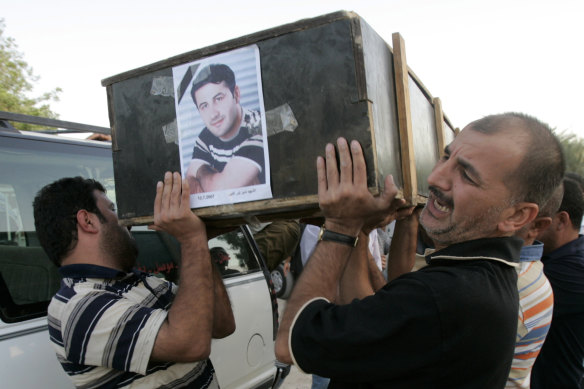
Namir Noor-Eldeen’s Reuters colleagues carry his coffin.
I wrote Maryam a 900-word summary of the many things I failed to do, including that I never asked US military contacts about the rules of engagement for Iraq. “I cheated my staff into thinking I was something I wasn’t,” I say.
Maryam doesn’t ask questions. Instead, she blows my mind by saying she has watched Collateral Murder. Before I can respond, Maryam says I’m not well enough to view it and probably won’t be at any point during my admission.
“What do you mean? The longer I leave it the harder it gets,” I say.
Maryam says my arousal levels are too high. I need to stabilise first, understand my triggers. She also thinks I want to punish myself by watching the tape.
“You need to learn to live with what happened,” Maryam says.
Several days later, I ask how I can possibly move on. “You’re processing, it will take time,” she says. “Don’t be impatient, your mind is moving too fast.“
PTSD has broad recognition across society even if its full reach and impact are poorly understood. I’ve come to Ward 17 expecting to meet soldiers, coppers, ambos and firefighters. But I have no idea PTSD reaches into virtually every occupation. I’ll meet a schoolteacher, a truck driver, a chef. I don’t know yet that scores of journalists I worked with in Iraq and elsewhere are struggling with mental illness. I’ll find out later that most stay quiet for fear of losing their jobs. I’m also largely ignorant of PTSD’s prevalence among survivors of childhood sexual abuse, rape and domestic violence and in marginalised communities.
What I’m really interested in is a condition called moral injury, because I think it describes the guilt and shame I feel over Namir and Saeed.
My volcanic anger has turned my home into a minefield for the people I love most in the world.
American psychiatrist Jonathan Shay coined the term in the mid-1990s after years of treating Vietnam War veterans with severe PTSD. It’s not that Shay didn’t think his patients had PTSD. But what he witnessed was something beyond the well-known combat scenarios of life-threat and fear: it was an indignant rage in men betrayed by their commanders in Vietnam and when they got home. He believed veterans could usually recover from the horror, fear and grief of war if their notion of “what’s right” hadn’t been violated.
Shay settled on the definition of moral injury as the betrayal of what’s right by someone who holds legitimate authority (for example, a military superior) in a high-stakes situation.
Moral injury remained a fringe concept until clinicians and researchers led by Brett Litz, a professor in the departments of psychiatry and psychology at Boston University, published an academic paper in 2009 that defined a second form of the condition among US veterans: “Perpetrating, failing to prevent, bearing witness to, or learning about acts that transgress deeply held moral beliefs and expectations.”
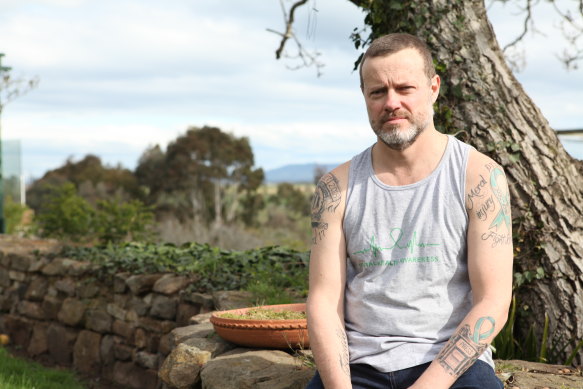
Author Dean Yates at home in Tasmania in 2019, after seeking help for his volatile moods.
Bingo, I thought, when a friend suggested I look at moral injury shortly before my admission to Ward 17. I’d failed to prevent Namir and Saeed’s deaths. Now I’m trying to understand where PTSD and moral injury intersect and differ. There appears to be some agreement among experts that they can coexist and that it’s possible to have one and not the other. PTSD is classified as a mental illness, whereas moral injury is not. Litz will tell me at the end of the year that journalists can suffer moral injury, too.
During my third week in Ward 17, I go to my desk and start typing.
Does this forensic review of my actions matter now? What will I achieve? I know deep down that the Apache pilot seemed genuine when he saw Namir peer around the corner. Namir did look suspicious. Does that justify unleashing such firepower?
Could I have lobbied harder for the tape? Yes, I could have stood up at press conferences … I was gutless. I froze … What’s important now? Getting on with life? Reconnecting with my family? Paying respects to Namir and Saeed? Atoning?
It’s time to tell the truth. I was cowardly when Assange released the video. I was shocked but wanted someone else to deal with it. That’s what I must live with, atone for. This is my moral injury. I email my notes to Maryam, who is pleased when I next see her. She says I’m making progress, being less hard on myself.
A week later, I tell her that Namir and Saeed no longer dominate my mind. I’ve stopped reading my Baghdad emails, even stopped obsessing about watching Collateral Murder. Maryam suggests all the talking and thinking is helping me process. I’m structuring these thoughts and learning to cope with them better.
I tell her I’ve been reading about therapy for soldiers and veterans with moral injury called Adaptive Disclosure that Litz and his colleagues have developed. The distress their patients suffer reflects a fair appraisal of culpability and responsibility from the war zone, they argue.
Rather than help veterans extinguish fear or challenge their beliefs about what happened – core elements to treating PTSD – Adaptive Disclosure takes a different approach. It focuses on acceptance, seeking forgiveness, self-compassion and finding meaning from trauma.
Veterans might seek to make amends, in real terms, or symbolically. They are encouraged to write letters, either apologising to the person they believe they wronged or confiding in a trusted friend or spiritual leader. They don’t have to send the letters.
“I want to write a letter to Namir and Saeed,” I tell Maryam. She gets animated even before I can finish.
“It’s a great idea,” she says, leaning forward, smiling. “I think you feel there is much you need to say, words inside your mind and heart that you haven’t said. This will be a way of getting the emotions out.” Little do I know how hard it will be to write that letter or how important it will be to making peace with myself.
This is an edited extract from Line in the Sand by Dean Yates (Pan Macmillan Australia, $37), out now.
Lifeline 13 11 14; Beyond Blue: 1300 224 636
To read more from Good Weekend magazine, visit our page at The Sydney Morning Herald, The Age and Brisbane Times.